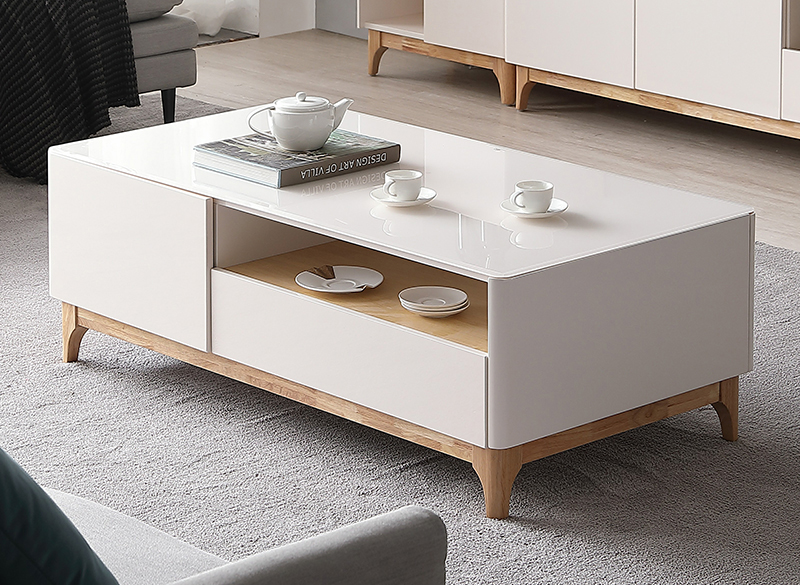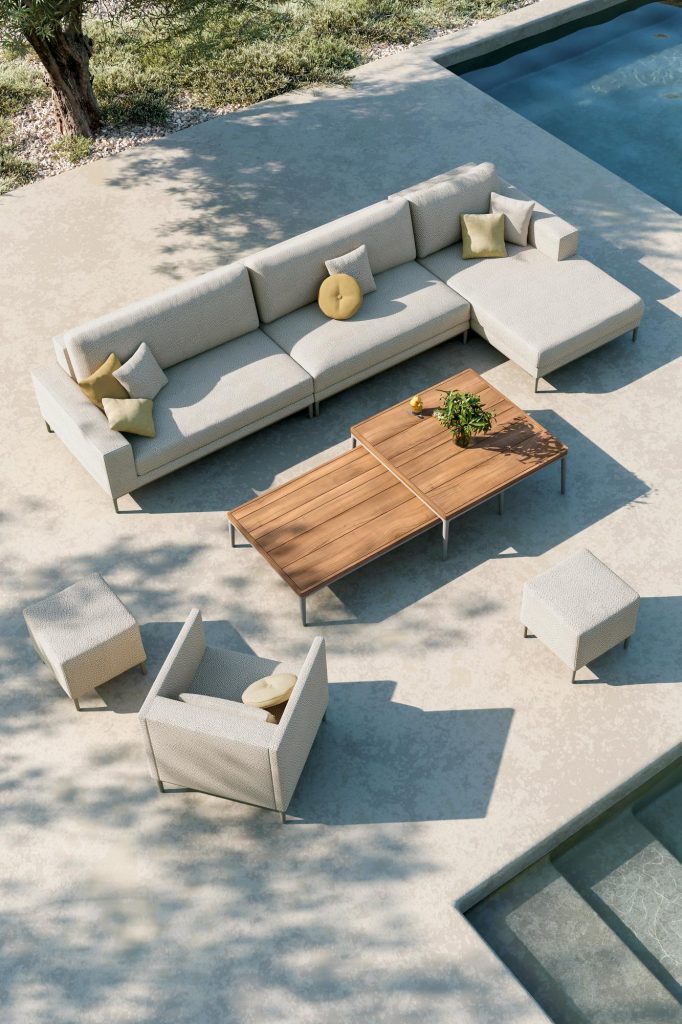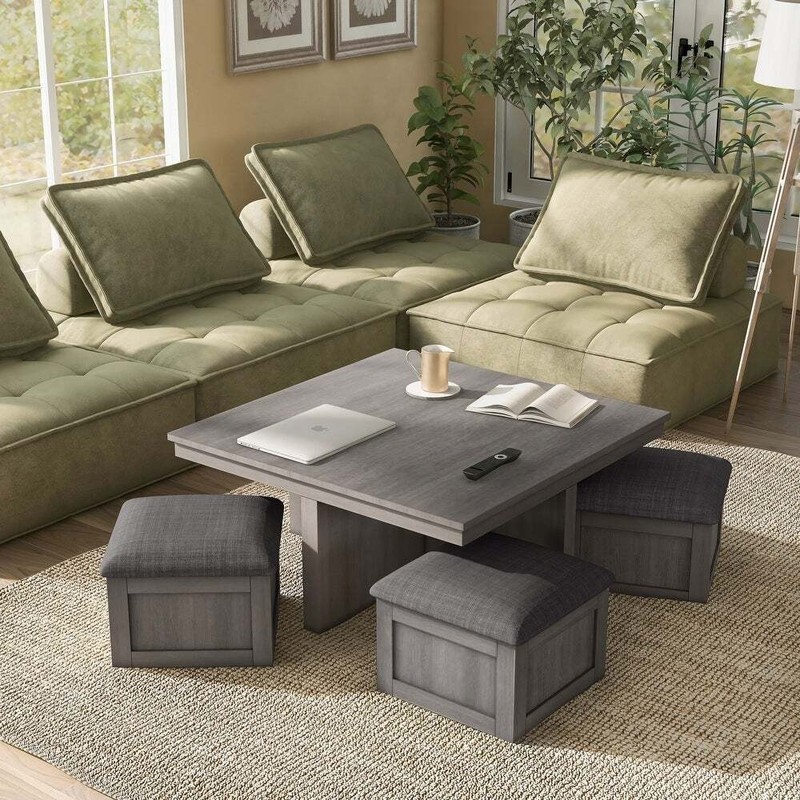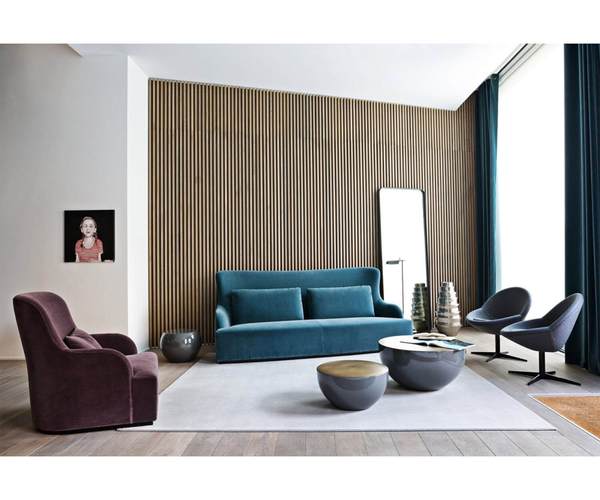Origin and Evolution of Coffee Tables:
Coffee tables have been around for centuries, but the concept of a low table for serving beverages and snacks emerged in the 17th century in Europe. Initially, these tables were called “tea tables,” as tea was the preferred drink of the upper class at that time. Tea tables were typically smaller than modern coffee tables and were used in formal drawing rooms to serve tea to guests.
As coffee became more popular in the 18th and 19th centuries, the tea table began to evolve into the coffee table we know today. In the 1920s, the term “coffee table” was coined to describe the low, long table in front of the sofa in a living room. Since then, coffee tables have become a staple of modern interior design.

Styles and Designs of Coffee Tables Over the Years:
Over the years, coffee tables have gone through various styles and designs. Here are a few notable ones:
Art Deco Coffee Tables:
In the 1920s and 30s, the Art Deco style dominated interior design. Geometric shapes, bold colors, and luxury materials such as Glass and chrome characterized art Deco coffee tables.
Mid-Century Modern Coffee Tables:
The 1950s and 60s saw the rise of the Mid-Century Modern style, which emphasized simplicity, functionality, and clean lines. Mid-Century Modern coffee tables were often made of wood and had simple, streamlined designs.
Contemporary Coffee Tables:
Today, coffee tables come in various styles and designs to fit any interior decor. Contemporary coffee tables may feature unique shapes, materials, and finishes and often prioritize functionality and versatility.
Overall, the history of coffee tables is an exciting reflection of the evolution of furniture design and the changing needs of society. From the formal tea table of the 17th century to the modern, multifunctional coffee tables of today, coffee tables continue to be an essential part of any living room or lounge area.
Materials used to make coffee tables
let’s examine the different materials used to make coffee tables and their pros and cons.

Wood:
Wood is one of the most popular materials used to make coffee tables. It comes in various types, including oak, cherry, walnut, and pine. Wood is durable, easy to maintain, and can be finished in multiple colors and styles to match any interior decor. The warmth and natural beauty of wood can add an inviting and cozy feel to a room. However, wood can be prone to scratches and dents, and some types may be more susceptible to damage from moisture and heat.
Glass:
Glass coffee tables are a popular choice for modern and contemporary interior design styles. Glass is easy to clean and durable and creates an illusion of space and lightness. It is also available in various shapes and sizes, making it versatile for any interior space. However, Glass is fragile and can be easily scratched or cracked. It can also show smudges and fingerprints easily, which may require frequent cleaning.
Metal:
Metal coffee tables can be made from various materials, including steel, iron, and aluminum. Metal tables are durable and sturdy and can be finished in various colors and styles. They can add a sleek and modern look to a room and are often used in industrial or minimalist interior design styles. However, if improperly maintained, metal can be prone to scratches, dents, and rust.
Stone:
Stone coffee tables are becoming increasingly popular due to their durability and natural beauty. Popular types of stone used for coffee tables include marble, granite, and slate. Stone is durable, heat-resistant, and can add a sense of luxury and sophistication to a room. However, stone can be heavy, difficult to move, and prone to staining and etching if not correctly sealed.
Overall, each material has its unique benefits and drawbacks when it comes to making coffee tables. By understanding these pros and cons, you can choose the material that best fits your needs and interior decor style.
Design principles of coffee tables
Let’s discuss the design principles of coffee tables, including their proportions, shape, and height, and how to choose the right coffee table for your room and seating arrangement.
Proportions:
The proportions of a coffee table are a vital factor to consider when choosing the right table for your space. Ideally, a coffee table should be about two-thirds the length of your sofa. The height of the table should also be proportional to the seating arrangement. A general rule of thumb is that the table should be the same height as the cushions on your sofa or slightly lower.
Shape:
The shape of your coffee table should complement the shape of your room and seating arrangement. Rectangular or oval-shaped coffee tables are popular for larger rooms, while round or square tables work well in smaller spaces. If you have a sectional sofa, a round or oval-shaped coffee table can help balance out the angles of the sofa.
Height:
The height of your coffee table should be appropriate for your seating arrangement. A coffee table that is too high or too low can be uncomfortable and awkward. As mentioned earlier, the height of the table should be proportional to the cushions on your sofa or slightly lower.
Choosing the Right Coffee Table:
When choosing the right coffee table for your room and seating arrangement, consider the style and material of the table. A coffee table that complements your interior decor style can tie the room together and create a cohesive look. Additionally, consider the functionality of the table. Do you need storage space or a table with a lift-top for dining? These features help you choose the right table for your needs.
Trends in coffee table designs
Let’s talk about the latest trends in coffee table designs, popular styles and designs of coffee tables in current times, and how to incorporate trendy coffee tables into your home decor.

Latest Trends:
The latest trends in coffee table designs include using unconventional materials such as concrete, terrazzo, and resin and incorporating natural elements such as wood and stone. Multi-level coffee tables with added storage space and lift-top tables for dining are also popular trends.
Popular Styles and Designs:
Mid-century modern-style coffee tables remain widespread, with clean lines and a minimalist aesthetic. Rustic and industrial-style coffee tables are also trendy, featuring raw materials and distressed finishes. Mirrored and glass coffee tables add a touch of elegance and glamour to a room. Organic shapes and curves, such as kidney and bean-shaped coffee tables, are also gaining popularity.
Incorporating Trendy Coffee Tables:
When incorporating a trendy coffee table into your home decor, consider your room’s existing style and color scheme. Choose a coffee table that complements your decor and adds interest without overwhelming the space. A unique coffee table can be a focal point in a room, but be sure to balance it with other decorative elements. Also, consider the functionality of the table and how it can serve your needs.
In summary, the latest trends in coffee table designs include using unconventional materials, multi-level tables, and lift-top tables. Popular styles include mid-century modern, rustic, industrial, and glass coffee tables. When incorporating a trendy coffee table, consider the existing style of your room and the functionality of the table.
What makes a coffee table a functional and aesthetically pleasing addition to a living room?
A coffee table can be a functional and aesthetically pleasing addition to a living room when it meets specific criteria:
Size and Proportions: A coffee table should be proportional to the size of the room and the surrounding furniture. It should be a manageable size in relation to the seating arrangement.
Shape: The coffee table should complement the shape of the room and the surrounding furniture. For example, a rectangular coffee table may work better in a room with a rectangular sofa, while a round coffee table may be more suitable for a curved sectional.
Height: The height of the coffee table should be appropriate for the seating arrangement. A coffee table that is too high or too low can be uncomfortable.
Material: The material of the coffee table should be durable and easy to maintain. Wood, Glass, metal, and stone are common materials used for coffee tables.
Storage: A coffee table with added storage space can be a functional addition to a living room, allowing easy access to books, magazines, and other items.
Style: The coffee table should complement the room’s decor. Choosing a coffee table that fits the room’s overall style can enhance its aesthetic appeal.
When all these factors are considered and balanced, a coffee table can be functional and aesthetically pleasing, making it a valuable addition to a living room.

What innovative ways have coffee tables been used in modern interior design?
Coffee tables have been used in many innovative ways in modern interior design. Here are a few examples:
Multifunctional coffee tables: Coffee tables with built-in storage, lift tops, or even built-in refrigerators have become popular in modern design. These tables provide both a functional and stylish addition to any living room.
Artistic coffee tables: Coffee tables have been transformed into artistic statement pieces featuring unique and creative designs. For example, some coffee tables feature a base of stacked books or a glass top displaying a seashell collection.
Oversized coffee tables: Large, big coffee tables have become a trend in modern interior design. These tables make a bold statement and can be used as a centerpiece in a large living room.
Mix and match coffee tables: Designers have started to use two or smaller coffee tables instead of one large table. This allows for more flexibility in seating arrangements and adds visual interest to the room.
Outdoor coffee tables: Coffee tables are no longer limited to indoor use. Outdoor coffee tables made of weather-resistant materials like metal and teak are now available, making creating a comfortable and stylish outdoor living space easy.
Overall, modern interior design has embraced the coffee table as a versatile and functional piece of furniture. From multifunctional to artistic designs, coffee tables can add style and functionality to any living space.
FAQs:
- How much should I pay for a coffee table?
The cost of a coffee table can vary greatly depending on factors such as material, size, and design.
- What is the latest trend for coffee tables?
The newest trend for coffee tables includes multifunctional tables, artistic statement pieces, and oversized tables. Mix-and-match coffee tables are also becoming more popular.
- Is it better to have a coffee table or not?
A coffee table is unnecessary, but it can add functionality and style to a living room. It can provide a surface for placing drinks or snacks, and it can also be a decorative centerpiece.
- Do people still use coffee tables?
Yes, coffee tables are still widely used in living rooms as a functional and decorative pieces of furniture.
- What kind of coffee table is the best?
The best coffee table for you will depend on your taste and the style of your living room. Consider size, material, and design when choosing a coffee table.
- What are the coffee table rules?
There are no hard and fast rules for coffee tables, but some general guidelines include ensuring that the table is proportional to the room and the seating arrangement and that it is not too tall or too low. It is also essential to consider the material of the table and whether it complements the rest of the room’s decor.
- Is it OK for a coffee table to be lower than a couch?
Yes, a coffee table can be lower than a couch as long as it is still within comfortable reach for placing items on the table.
- Should your coffee table be as long as your couch?
No, your coffee table does not have to be as long as your couch. It should be proportional to the size of the room and the seating arrangement.
- Do coffee tables make a room look bigger?
A coffee table alone may not make a room look bigger, but the right coffee table can complement the overall design and flow of the room, creating an illusion of more space.


